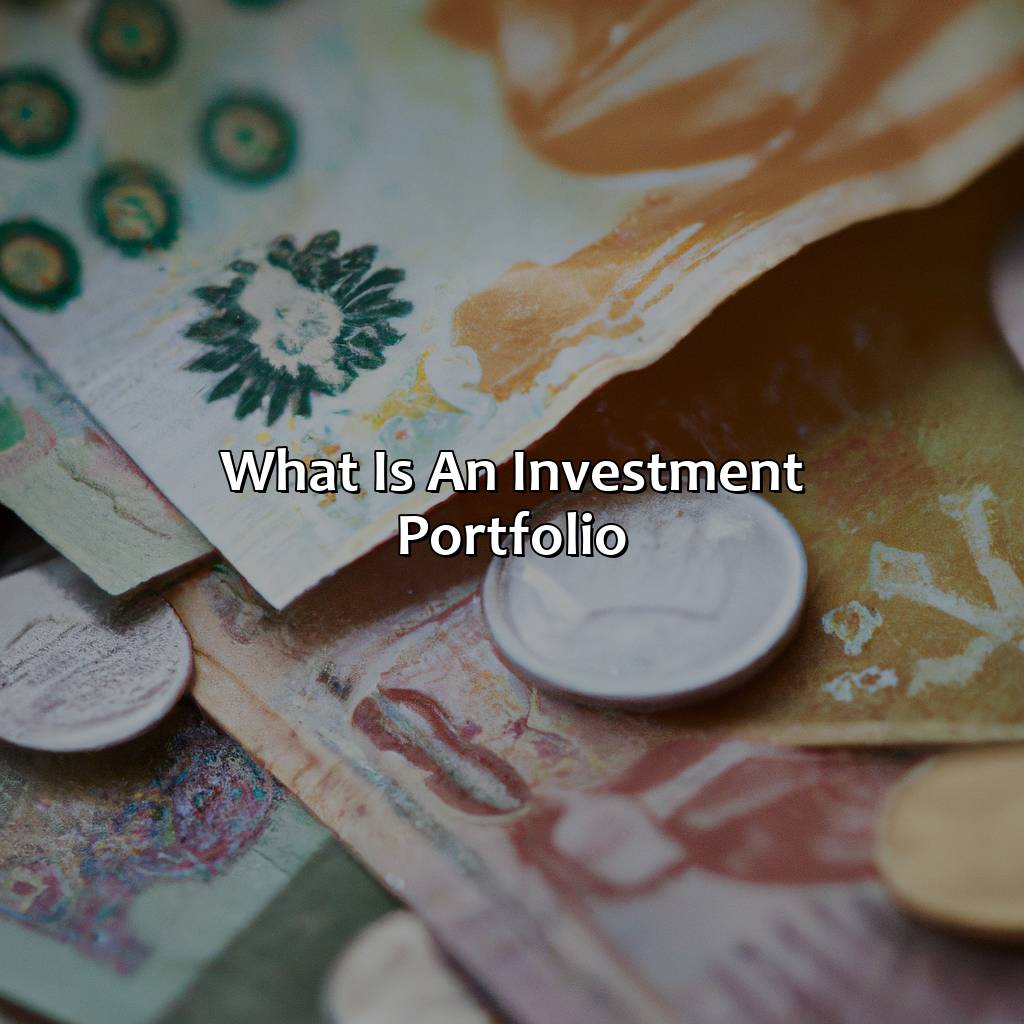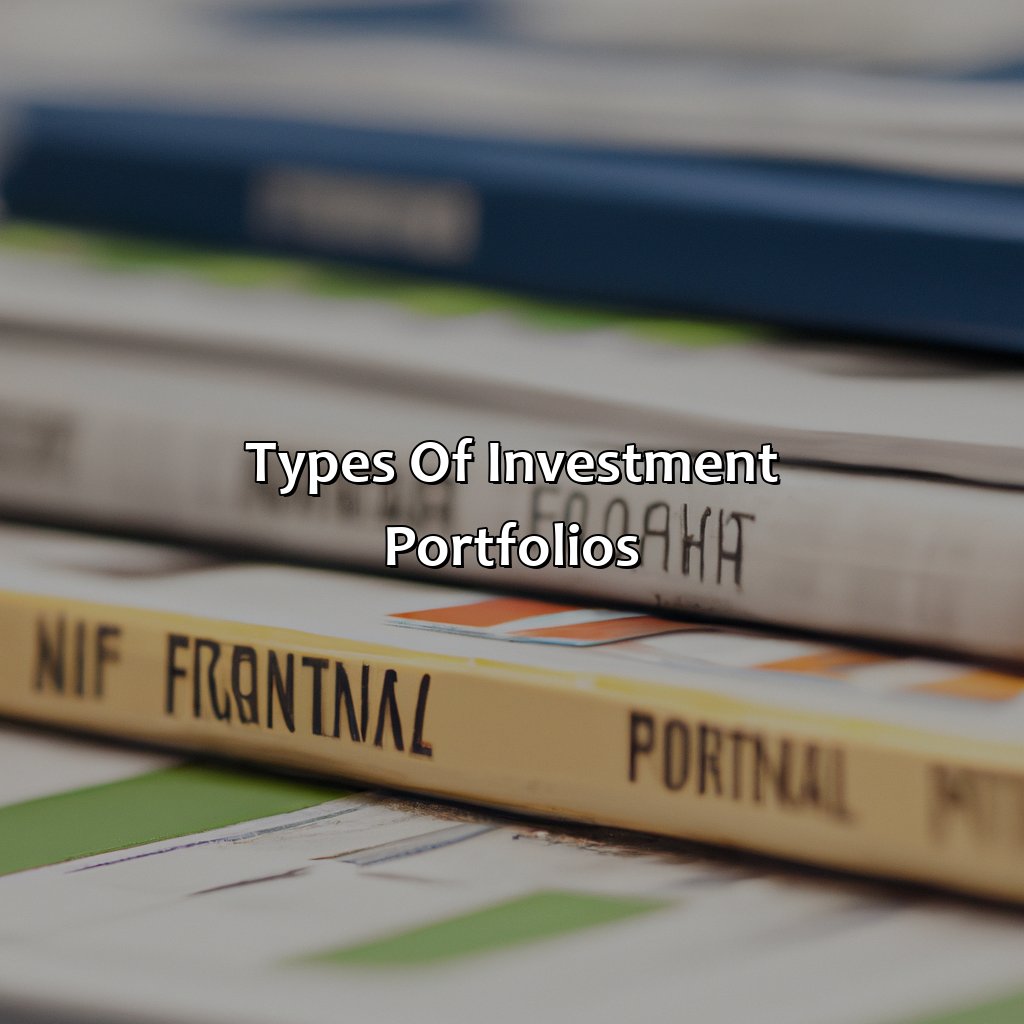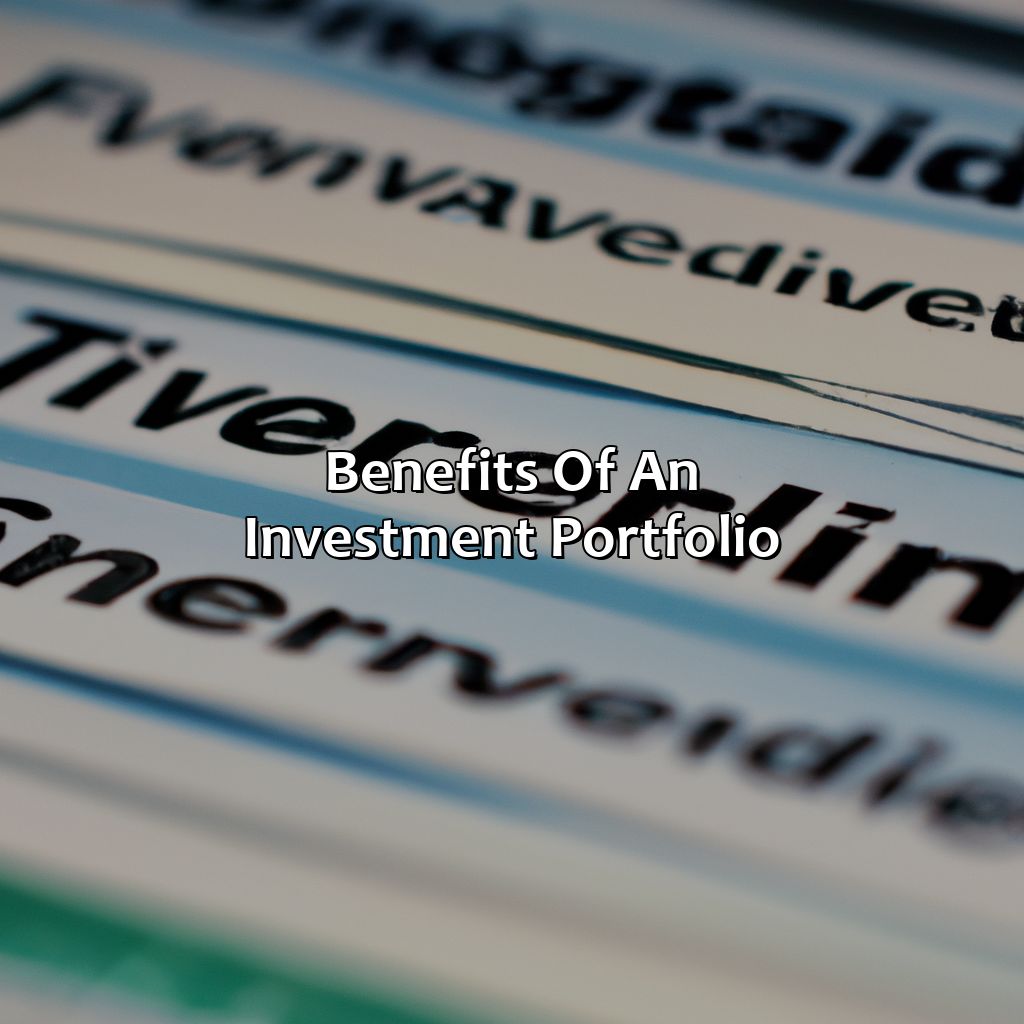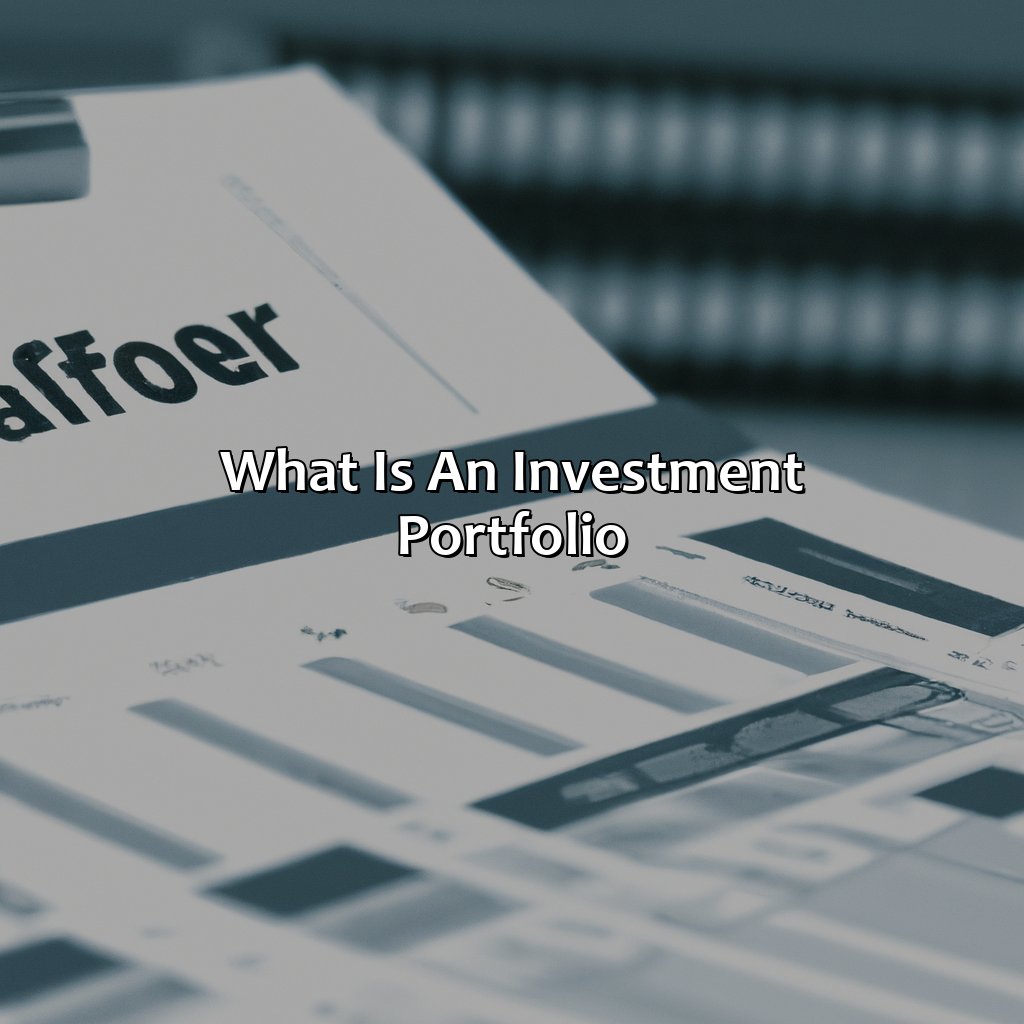What Is An Investment Portfolio?
Key Takeaway:
- Investment portfolio is a collection of assets owned by an individual or organization with the goal of achieving financial returns.
- Types of investment portfolio include passive, active, and balanced, and each type differs in terms of investment strategy and risk level.
- An investment portfolio offers benefits such as diversification, risk management, and potential for higher returns, and building a portfolio requires defining investment goals, determining risk tolerance, choosing asset classes and investments, and regularly rebalancing the portfolio.
Struggling to make sense of your finances? You’re not alone. Crafting an investment portfolio is a vital step towards achieving financial security. Learn how to navigate the world of investments – and start building your own portfolio today.
What is an Investment Portfolio?
Investment Portfolio: A Comprehensive Explanation
An investment portfolio is a collection of assets such as stocks, bonds, mutual funds, real estate, and commodities. These assets are chosen by an investor based on their financial goals, risk tolerance and investment strategy.
The portfolio is managed to optimize the return on investment, minimize risk, and achieve desired financial objectives.
Within an investment portfolio, the assets are diversified across different asset classes to spread risk. This is known as asset allocation. The diversification helps to offset losses that may be incurred from one asset with gains from another. It also aids in reducing volatility.
Moreover, investment portfolios are not static, they evolve over time based on changes in economic conditions, investor preferences or investment objectives. A skilled portfolio manager continually assesses the portfolio and rebalances the asset mix as needed.
According to a recent report by Business Insider, 70% of investment advisors recommend having a diversified investment portfolio for long term success.
In summary, an investment portfolio is a carefully selected cluster of assets aligned with the investor’s financial goals and managed to optimize returns and minimize risk.

Image credits: retiregenz.com by David Duncun
Types of Investment Portfolios
Want to diversify your investment strategy? Read on to learn about the different types of investment portfolios. There are three main subsections:
- Passive Investment Portfolio
- Active Investment Portfolio
- Balanced Investment Portfolio
This type is for those who prefer a slow and steady approach to investing. It involves buying and holding a diversified mix of assets, such as stocks and bonds, without trying to predict market movements.
This type is for those who want to make more informed investment decisions by studying market trends, company performance, and economic indicators. The goal is to buy and sell assets frequently to maximize returns.
This type is a mix of passive and active investment strategies and provides a balanced approach to investing. For instance, the investor may use a mix of stocks and bonds, but actively trade certain assets based on market trends and insights.
Each offers unique features to fit your investment goals.

Image credits: retiregenz.com by Yuval Washington
Passive Investment Portfolio
Passive investment portfolio is a strategy that aims to match market performance without an active approach. It requires minimal effort and expertise from investors and focuses on reducing fees by investing in index funds and exchange-traded funds. This type of portfolio provides exposure to diverse sectors and offers long-term growth potential with low risks.
Investors who prefer passive investment portfolios often prioritize a buy-and-hold approach, seeking long-term growth and stable returns through cost-effective investments. By avoiding frequent trading and relying on market trends, they hope to achieve steady returns without significant fluctuations or increased costs.
Passive investment portfolios offer several advantages over active ones, including lower fees, minimal knowledge requirements, reduced trading activity, tax efficiency, and more time to focus on other goals.
Once I met a retired couple who had invested most of their savings in passive investment portfolios following recommendations from financial advisors. They were pleased with the consistent returns, lack of stress associated with active strategies, and the ability to passively grow their wealth over time without constantly monitoring the market.
Think of an active investment portfolio like a high-maintenance pet, requiring constant attention and care, but offering potential rewards for the diligent owner.
Active Investment Portfolio
Investors who actively manage their portfolios are said to have an Agile Investment Portfolio. This type of portfolio is created by continuously monitoring market trends, making necessary adjustments in real-time and maximizing returns on investments. The investments made here require a hands-on approach from the investor and include individual stocks, commodities, fixed income securities and ETFs.
Agile Investment Portfolios typically carry higher risk as they aim to outperform the market. Investors should have advanced knowledge of financial markets and investment strategies before opting for this type of portfolio. An Agile Investment Portfolio requires daily attention to maximize gains.
It’s important to note that an Agile Investment Portfolio is not suitable for every investor as it has a higher degree of volatility than passive portfolios. This type of investment portfolio benefits investors who thrive on taking calculated risks and who are experienced in navigating financial markets.
In the past few decades, with advances in technology, active investment management has been easier than ever before. With just a few clicks, investors can execute trades on multiple platforms optimizing returns continuously.
Balanced investment portfolios are like a balanced breakfast – a healthy mix of stocks, bonds, and cash to start your financial day off right.
Balanced Investment Portfolio
A well-rounded investment portfolio comprising a diverse range of investments is a ‘Harmonized Investment Portfolio’. It helps manage the risks and rewards from different investment vehicles. Here are five key features of it:
- Includes a mixture of stocks, bonds, and cash depending on the investor’s risk tolerance and financial goals.
- It balances both capital appreciation and consistent income streams.
- Market trends do not have an enormous impact since the diversification decreases single-asset risks.
- The mix maintains constant as purchases and sales offset each other based on internal performance benchmarks.
- The asset allocation strategy follows both short-term needs and long-term goals across multiple market conditions efficiently.
Additionally, Harmonized Investment Portfolio enables investors to mitigate their losses during economic or political downturns through appropriate reallocation plans without disinvesting from the equity market entirely.
According to Morningstar’s research team, Balanced funds attracted $5 billion in investment over the first quarter of 2021.
An investment portfolio is like a buffet – you get to mix and match your options, but always leave room for dessert (i.e. profits).
Benefits of an Investment Portfolio
To optimize your investments, diversification and risk management are essential. Comprehending the advantages of a portfolio is vital. Diversification, risk handling, and possible high returns are the key points that will be examined in this part.

Image credits: retiregenz.com by Harry Duncun
Diversification
The essence of varied diversification is to reduce one’s risks by investing in different asset classes. This approach offers an individual the opportunity to spread his or her investments across many stocks, bonds, mutual funds, and sectors, and geographies while avoiding overexposure. By mixing up your portfolio with a variety of asset types and sectors that behave differently in various economic conditions ensures smooth sailing irrespective of market fluctuations.
When you are making an investment portfolio, never put all your eggs into one basket; instead, divide it equitably amongst multiple assets. A diversified portfolio could be a combination of large-cap and small-cap equities, treasury bonds, funds that track specific markets or industries with differing risk appetites. Thus you can optimize your returns while reducing the potential scenarios that could adversely affect your portfolio.
A robust strategy for implementing multiple diversifications entails examining broad categories such as geographic locations and corresponding economic models. In doing so, consider asset classes poised for accelerated growth. Every type of investment has its strengths and weaknesses regardless of its location; identifying these factors would enable one to gain further insights when mapping out their investments’ future prospects.
Pro Tip: A beyond-the-basics toolset like advanced algorithmic analysis models can provide a more thorough investigation based on both historical data trends and current market outlooks rather than employing guesswork alone for informed decision-making in portfolio management practices.
Risk management is like wearing a seatbelt – nobody wants to do it, but if shit hits the fan, you’ll be glad you did.
Risk Management
Investment portfolios are effective risk mitigation tools that adeptly reduce investment hazards and uncertainties. By carefully diversifying investments across multiple asset classes, the likelihood of losing money is substantially decreased. Proper asset allocation and security selection helps mitigate risks by reducing market volatility exposure.
Furthermore, maintaining a well-diversified portfolio results in reduced systematic risk and a heightened ability to ride through economic downturns. This intentional curation of investments reinforces resilience against economic pressure which is more sustainable in the long-term.
In addition, utilizing effective strategies such as dollar-cost averaging and periodic rebalancing helps avoid knee-jerk reactions to market events, resulting in reduced losses.
A true history demonstrates how effective diversification can be during turbulent times. During the 2008 financial crisis, those with well-diversified portfolios did not experience significant losses unlike those who over-invested in single assets or securities. The difference? Effective risk management via an investment portfolio.
Who needs a fortune teller when you have a well-diversified investment portfolio? It’s like seeing into the future, but with actual returns.
Potential for Higher Returns
Investing in a diverse range of assets presents a plethora of profitable opportunities to maximize your returns. By optimizing your financial assets and minimizing exposure to risk, your portfolio can deliver potential for higher returns. The structuring of your portfolio should be based on your investment goals and the market scenario.
Diversification is key to ensuring a potential for higher returns in an investment portfolio. Allocating your funds across different asset classes like stocks, bonds, real estate, commodities, and cryptocurrencies could offer protection against market volatility and fluctuations. Keeping a diversified portfolio allows you to maintain exposure to high-growth investments while mitigating risks associated with investing in a single entity.
Another strategy that could add value to your investment is adopting long-term thinking in asset allocation. By identifying assets likely to appreciate over time by looking at the historical trend data and taking advantage of their growth trajectory, you stand the chance of earning considerable returns when you sell them after some years.
With market dynamics constantly changing, investors must keep monitoring their portfolios frequently for appropriate adjustments regularly. Generally speaking, maintaining a diverse range of assets will help spread risk within the portfolio while retaining the potential to generate better returns.
Don’t miss out on opportunities to generate wealth in the form of high investment returns due to lack of diversification or frequent monitoring of your investments. With its limitless benefits, creating an investment portfolio suited to your financial objectives would ensure that you maximize profit generation opportunities while also mitigating risks along the way.
Building an investment portfolio is like building a Lego castle, but instead of colorful bricks, you’re using money and instead of a cool fortress, you get a retirement fund.
How to Build an Investment Portfolio
For a solid investment portfolio with your desired returns and risk-taking ability, take these steps:
- First, work out your investment goals.
- Second, assess your risk-taking capacity.
- Next, pick the right asset class and investments.
- Finally, regularly adjust your portfolio balance.
With these steps, you can create a portfolio balancing your risk and return.

Image credits: retiregenz.com by David Washington
Define Investment Goals
Investment goals refer to the desired outcomes that an investor hopes to achieve by investing their money. These goals can be short-term or long-term and vary depending on factors such as age, income, risk tolerance, and investment experience. It is crucial to define your investment goals as this will help you determine the appropriate investment strategy and the types of investments that will best meet your needs.
Understanding your risk tolerance level is essential in defining your investment goals. The higher your risk tolerance, the greater the potential returns you can expect from your investments. Conversely, if you have a low risk tolerance, you may want to focus on less risky investments that offer more stability but lower potential returns. Additionally, it’s important to consider the time frame for achieving each goal because this will dictate how aggressively or conservatively you should invest.
To successfully achieve one’s investment goals requires discipline and careful planning throughout the investment journey.
A study conducted by Fidelity found that investors who had defined specific financial objectives tended to perform better than those who did not have specific targets in place when building their investment portfolio.
Remember, investing is like a rollercoaster ride – determining your risk tolerance is like deciding whether to sit at the front or the back.
Determine Risk Tolerance
Investment Portfolio Risk Assessment:
Assessing your risk tolerance is a crucial step in building an investment portfolio. Identifying the level of risk you are willing to take on can help determine which investments align with your goals. It’s important to consider personal factors such as age, financial situation, and investment experience when determining risk tolerance. By understanding your risk tolerance, you can make informed decisions on how to allocate your investments.
To assess your risk tolerance, it’s important to evaluate the potential risks and rewards of different investment options. This includes analyzing historical performance, volatility, and diversification strategies. Investments with higher potential returns generally have higher levels of risk, while lower risk investments typically offer lower returns.
Consider also seeking advice from a financial advisor who can provide guidance on suitable investment options based on your risk profile. Keeping a balanced portfolio that aligns with your risk tolerance goals over the long-term will create stability even in volatile markets.
Don’t miss out on reaching your financial goals by failing to analyze and understand your own investment preferences. Take control of your future today by assessing your risk profile and building a diverse investment portfolio that aligns with it. Choosing asset classes and investments is like assembling a puzzle, just with higher stakes and fewer missing pieces.
Choose Asset Classes and Investments
Asset Class Selection and Investment Portfolio Building
When building an investment portfolio, it’s essential to choose the right asset classes and investments. Here’s what you need to know:
- First, determine your risk tolerance and investment goals.
- Next, select asset classes that align with your objectives, such as stocks, bonds, and real estate.
- Within each asset class, diversify your investments to reduce risk. For example, choose multiple stocks in different sectors.
- Regularly monitor and adjust your portfolio to ensure it remains aligned with your goals.
To further optimize your investment portfolio, consider researching alternative asset classes such as private equity or commodities.
Pro Tip: When selecting investments, consider using a mix of passive and active strategies for optimal performance.
Don’t be afraid to shake things up in your investment portfolio, it’s not a snow globe after all.
Rebalance the Portfolio Regularly
Regularly adjusting your investments can be essential to maintaining a balance that will keep your returns steady over time. Here are some tips for portfolio adjustments:
- Begin by reviewing recent performance and aligning goals with the current market status.
- Check on allocation percentages and ensure they are still aligned with objectives.
- Rebalance the portfolio to reduce risk or capitalize on changing trends.
- Consider tax ramifications when selling any investments for rebalancing purposes.
- Finally, monitor progress over time to identify further opportunities for growth or adjustment.
In addition to these five steps, it is important to note that rebalancing should not occur too frequently or impulsively. Rather, it should be done with intention and strategic planning.
Taking these actions can help you avoid missed investment opportunities and maintain a healthy, diversified portfolio. Don’t let fear of missing out guide your decisions — make smart choices based on market analysis and long-term goals.
Five Facts About Investment Portfolios:
- ✅ An investment portfolio is a collection of assets, such as stocks, bonds, and real estate, held by an individual or institution. (Source: Investopedia)
- ✅ The purpose of an investment portfolio is to generate income and/or capital gains while minimizing risk. (Source: Fidelity)
- ✅ Diversification is key to building a successful investment portfolio, as it helps spread risk across various assets and classes. (Source: Charles Schwab)
- ✅ The asset allocation of an investment portfolio should be aligned with the individual’s or institution’s risk tolerance, investment goals, and time horizon. (Source: Vanguard)
- ✅ Regular monitoring and rebalancing of an investment portfolio is important to ensure it stays aligned with the individual’s or institution’s goals and risk tolerance. (Source: M1 Finance)
FAQs about What Is An Investment Portfolio?
What is an investment portfolio?
An investment portfolio refers to a collection of investments held by an individual, corporation, or institution. Such investments could include stocks, bonds, real estate, and mutual funds. The purpose of an investment portfolio is to diversify investment risks and earn potential returns.
What are the benefits of having an investment portfolio?
There are several benefits of having an investment portfolio such as diversification, potential for higher returns, flexibility, and easy management. Investment portfolios offer a diversified mix of assets that limit the risk of loss and increase the chances of generating returns.
How do I build an investment portfolio?
Building an investment portfolio requires careful planning, research, and strategy. It is essential to identify your investment goals and financial needs, determine your risk tolerance, choose an asset allocation strategy, and select suitable investments. Ideally, you should seek the assistance of a financial advisor to help you build a diverse investment portfolio that aligns with your goals.
What is the ideal asset allocation for an investment portfolio?
The ideal asset allocation for an investment portfolio varies based on factors such as age, risk tolerance, and investment goals. In general, experts recommend an asset allocation of 60% stocks and 40% fixed income securities for individuals with a moderate risk tolerance. It is always a good idea to consult a financial advisor to determine the ideal asset allocation for your investment portfolio.
How often should I rebalance my investment portfolio?
Rebalancing an investment portfolio is the act of adjusting the asset mix to maintain the desired level of risk and return. The frequency of rebalancing varies depending on the portfolio’s size, complexity, and goals. Experts recommend rebalancing the portfolio at least once a year but some suggest quarterly or monthly rebalancing may be more appropriate for some portfolios.
What are the risks associated with an investment portfolio?
Investment portfolios carry various types of risks such as investment risks, market risks, and inflation risks. Investment risks stem from the possibility of losing money on an investment. Market risks arise from economic factors such as inflation, interest rates, and political instability. Inflation risks result from the erosion of the purchasing power of money due to rising prices. Proper diversification and asset allocation can help mitigate these risks.
